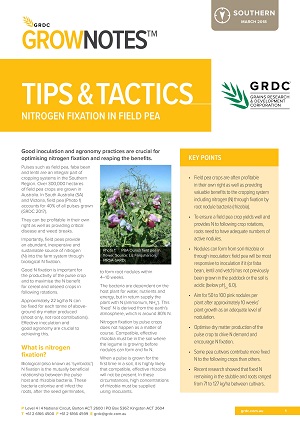Nitrogen fixation in field pea
Nitrogen fixation in field pea
Published: 01 Mar 2018
Field peas provide an abundant, inexpensive and sustainable source of nitrogen (N) into the farm system through biological N fixation.
Good N fixation is important for the productivity of the pulse crop and to maximise the N benefit for cereal and oilseed crops in following rotations.
Key points
- Field pea crops are often profitable in their own right as well as providing valuable benefits to the cropping system including nitrogen (N) through fixation by root nodule bacteria (rhizobia).
- To ensure a field pea crop yields well and provides N to following crop rotations, roots need to have adequate numbers of active nodules.
- Nodules can form from soil rhizobia or through inoculation: field pea will be most responsive to inoculation if it (or faba bean, lentil and vetch) has not previously been grown in the paddock or the soil is acidic (below pHCa 6.0).
- Aim for 50 to 100 pink nodules per plant after approximately 10 weeks’ plant growth as an adequate level of nodulation.
- Optimise dry matter production of the pulse crop to drive N demand and encourage N fixation.
- Some pea cultivars contribute more fixed N to the following crops than others.
- Recent research showed that fixed N remaining in the stubble and roots ranged from 71 to 127 kg/ha between cultivars.
Download PDF
Region: South
GRDC Project Code: DAS00108, DAS1207-004RTX, UOA1207-001RTX,

